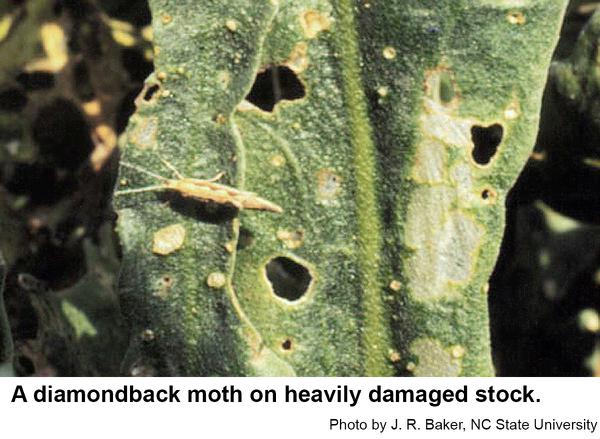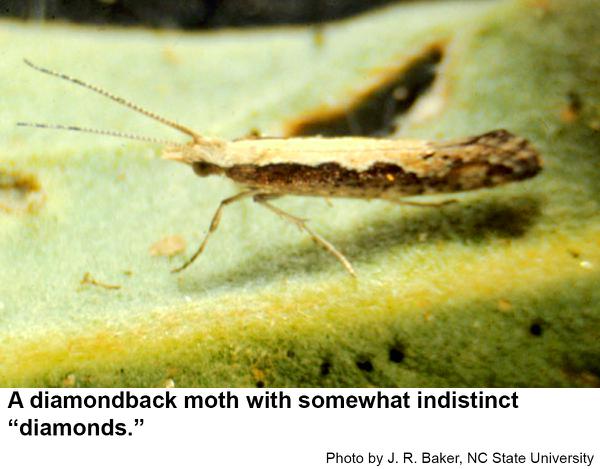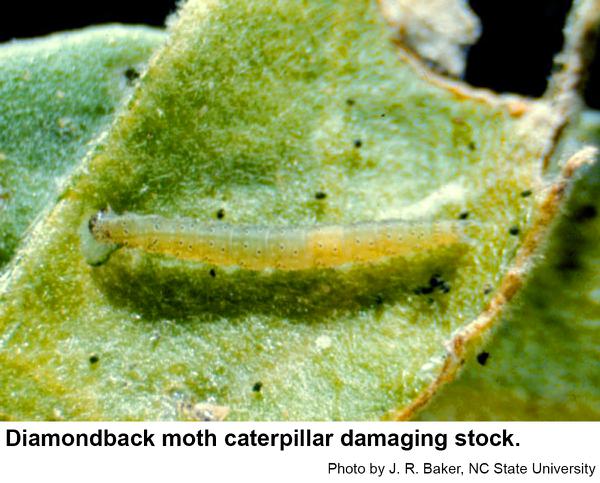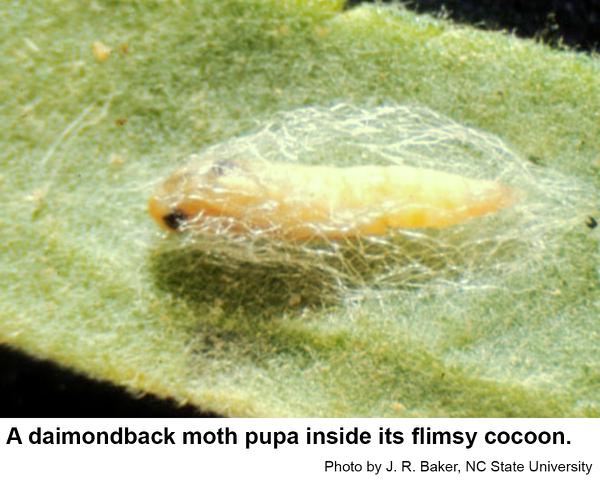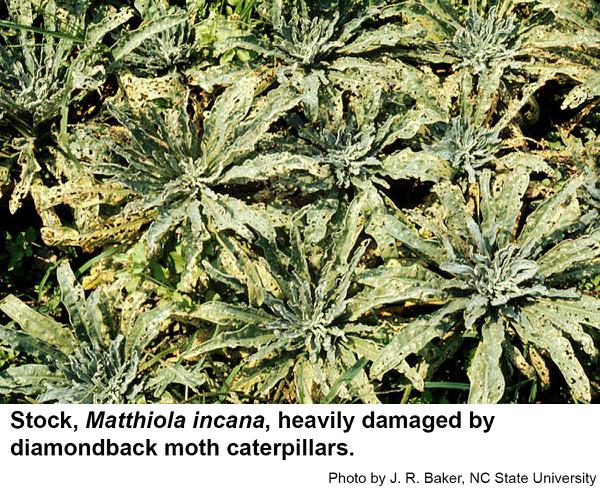Description and Biology
The diamondback moth, Plutella xylostella, has narrow forewings, conspicuously fringed hind wings, and an ¾ inch wingspan. When at rest, the wings of the male come together to form a line of white or pale yellow diamonds down the middle of the back. Females moths have a crenulated line down the back. Females lay minute oval, pale yellow eggs singly or in groups of two to eight. Each female lays about 150 eggs in her lifetime, but some have laid as many as 300! The caterpillars taper slightly at both ends and are pale green with black heads and scattered black hairs. They grow to about to about 3/8 inch long. Diamondback moth caterpillars thrash rapidly when disturbed, often dropping from the plant and hanging by a silk thread. The yellowish pupa is enclosed within a loosely spun, gauze-like cocoon about 3/8 inch long. Diamondback moths overwinter as adults among field debris of crucifer crops. Although the moths are weak fliers, they can be carried long distances by prevailing winds. In spring, eggs are laid, singly or in groups of two or three on foliage. Tiny caterpillars hatch from eggs a few days later and feed for about 10 to 30 days first as leafminers. They soon emerge to infest the undersides of leaves. Mature caterpillars enclose themselves in loose cocoons attached to lower leaf surfaces and then pupate. About two weeks later, a new generation of moths emerge. We have five or six generations per year in North Carolina.
Host Plants
Caterpillars of the diamondback moth feed almost exclusively on cole crops such as broccoli, cabbage and kale (also ornamental varieties) in the vegetable garden and in commercial greenhouses. It is also a pest of alyssum, candytuft, watercress, and stock (a flowering crucifer sometimes grown in ornamental greenhouses). In addition, diamondback moth caterpillars feed on some weeds such as mouse-ear cress, Whitlow grass, shephed's purse, and spring cress that may be growing under the benches or just outside the greenhouses. Diamondback moth caterpillars feed on all plant parts, but prefer the undersides of older leaves, crevices between loose leaves, and young buds. They eat small holes in leaves and buds, or feed superficially.
Residential Recommendation
The diamondback moth has acquired resistance to many kinds of pesticides including some of the Bacillus thuringiensis pesticides that are labeled for the diamondback moth (with three or zero day waiting periods for vegetable crops!). If diamondback caterpillars survive insecticides labeled for use in vegetable gardens or residential landscapes (on flowers), it may be better to consider growing species not in the family Cruciferae.
References
- Insect and related Pests of Flowers and Foliage Plants. Baker, J. R., ed. 1994. North Carolina Cooperative Extension Service Publication AG-136. 106 pp.
- Common name: diamondback moth, scientific name: Plutella xylostella (Linnaeus) (Insecta: Lepidoptera: Plutellidae). Capinera, J. L. 2012 (revised). Featured Creatures, Entomology & Nematology, FDACS/DPI, EDIS, Publication Number: EENY-119.
- .Insect and related Pests of Vegetables. Sorenson, K. A. and J. R. Baker, eds. 1994.North Carolina Cooperative Extension Service Publication AG-295. 180 pp.
- Extension Plant Pathology Publications and Factsheets
- Horticultural Science Publications
- North Carolina Agricultural Chemicals Manual
For assistance with a specific problem, contact your local Cooperative Extension Center.
This Factsheet has not been peer reviewed.
Publication date: Sept. 26, 2016
Reviewed/Revised: June 30, 2021
Recommendations for the use of agricultural chemicals are included in this publication as a convenience to the reader. The use of brand names and any mention or listing of commercial products or services in this publication does not imply endorsement by NC State University or N.C. A&T State University nor discrimination against similar products or services not mentioned. Individuals who use agricultural chemicals are responsible for ensuring that the intended use complies with current regulations and conforms to the product label. Be sure to obtain current information about usage regulations and examine a current product label before applying any chemical. For assistance, contact your local N.C. Cooperative Extension county center.
N.C. Cooperative Extension prohibits discrimination and harassment regardless of age, color, disability, family and marital status, gender identity, national origin, political beliefs, race, religion, sex (including pregnancy), sexual orientation and veteran status.

